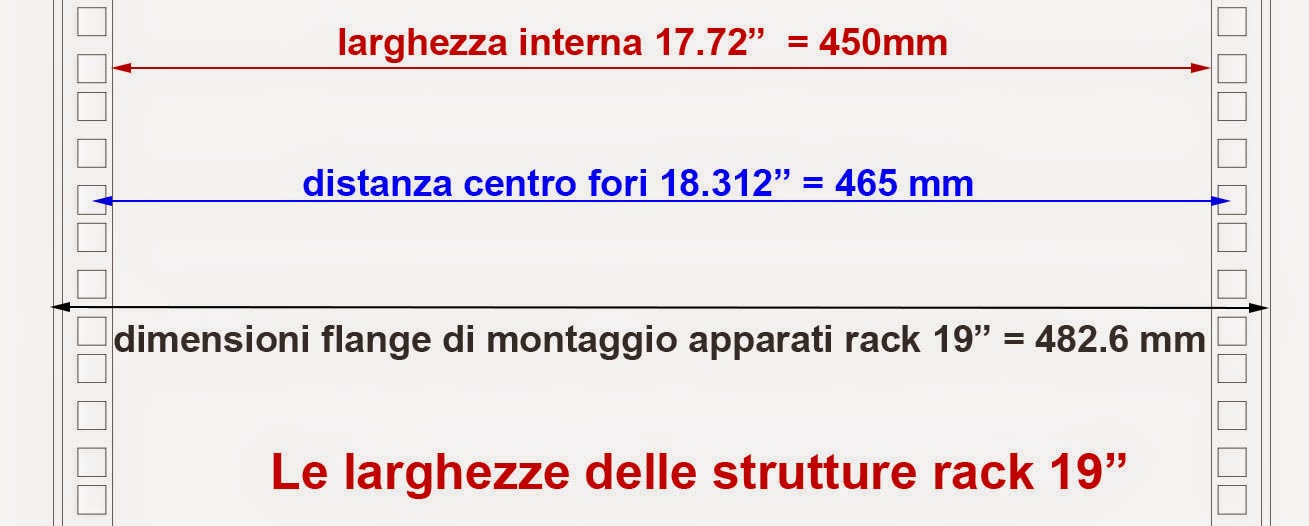
The term rack in electronics mechanics indicates a standard component installation system consisting of a modular structure based on the rack unit that identifies the width and height of the objects installed in it.
The rack structure is realized by means of parallel vertical bars also called uprights (always in right and left pair) characterized by a fixed distance (usually 19 inches) and by the presence of a series of holes distributed along the entire length, 3 holes for each Unit of the structure.
The structure with 19" system is currently the most used in electronics and computer science.
A rack unit often abbreviated as U (Unit), RU (Rack Unit), HU (Height Unit), is a unit of measurement used to indicate the height of components installed in a 19" rack. A U corresponds to 1.75 inches (44.45 mm) and is characterized by the presence of 3 holes at different distances (3 square breaks of 9.5 x 9.5 mm for cage nuts in modern structures).
Rackmount equipment manufacturers specify the height footprint of the 1U apparatus for a rack unit, 2U, 3U, and so on. This allows you to easily and immediately calculate the space required for the complete infrastructure.
The definition of the rack unit size is based on the standard specifications EIA-310, IEC IEC-60297-1, IEC-60297-2, IEC-60297-3 and later.

The width of a 19" rack cabinet 482.6 mm refers to the maximum width of the objects to be mounted including the side fixing fins ("ears", "brackets"). The distance between the centre of the holes in the right vertical bar and the relevant holes on the left bar is 465 mm and the input light between these two vertical bars is 450 mm.
The width of the equipment mounted inside the 19" rack called subracks, normally ranges between 40 and 43 cm and is often translated into TE or HP - Horizontal Pitch. Specifically a drawer mounted in a 19" rack measures 84TE / HP. Some equipment does not occupy the full width of the rack, but uses only half of it. In this case they can be mounted on special supports alone or in pairs. This size is known as half rack, half length, half width, 42TE, 42HP.
Are possible but less frequent, realizations with different widths, for example 60TE / HP.
Metal structure based on at least 2 vertical sheets called Rack Uprights on which electronic, audio-video or networking equipment such as servers, switches, hubs, routers, patch panels and switchboards are fixed with screws or placed on special guides.
Rack structures can be completely open (open frame or frames), completely closed (cabinets), or intermediate structures with covered parts and others directly accessible.
The rack unit is the only constant point of all structures that then differ in:
Number of rack units (structure height)
depth of structure
width of the structure
number and type of rack posts (usually 4 for floor cabinets 2 in built-in cabinets)
Type of doors, walls and finishes
IP rating of protection (how isolated the inside is from the outside of the rack)
These cabinets are widely used in the industrial, telecommunications and IT sectors, they serve to contain servers, switches, switchboards and other equipment in an orderly and easily accessible way. In this way, in the event of a fault or when updating a component, the replacement of the device or its maintenance can be carried out quickly and cleanly and safely.
Floor rack cabinets are used in many areas, the main ones being server installation and networking.
These are characterized by:
high depth 1000 mm
particular solidity
presence of 4 or 6 uprights
effective cooling system through front and rear doors in perforated steel to ensure a high heat exchange with the outside, or through the air conditioning system of the single cabinet (only if equipped with a high IP degree of protection)
Anti-tipping system
Networking cabinets are characterized by:
less depth 800, 600, 500 mm
often there are only 2 front pillars
greater width, generally 800 mm when you have to make a structured wiring or in any case you need a lot of space on the outer sides of the uprights to be able to pass a large number of cables
higher IP degree of protection, the front door is generally in shatterproof glass and the rear in blind steel
Cable access from the bottom and roof protected by combs and guillotines that prevent dust from entering
Wall rack cabinets are used for networking applications. They are designed to contain PBXs, routers, switches and patch panels. Ordered and collected inside a cabinet, these peripherals are more protected and easily manageable both at the time of installation and subsequently during maintenance.
These cabinets are characterized by:
Less depth, generally less than 600 mm
only two posts (weight and size of networking devices do not require 4-point fixings)
The glass front door is often the only access to the cabinet even if there are more complex versions with removable sides and "double section" or possibility to open the back of the cabinet.
subrack.eu + armadi-rack.it© are run by M.D.W. srl - About Us
M.D.W. srl Chamber of Commerce, Bologna
REA n° 465866
PI/CF 02766841205
Legal office:Piazza Minghetti, 4/D
Bologna 40124 BO, Italy
Operating office:Via Edmondo De Amicis 7
Casalecchio di Reno 40033 BO, Italy